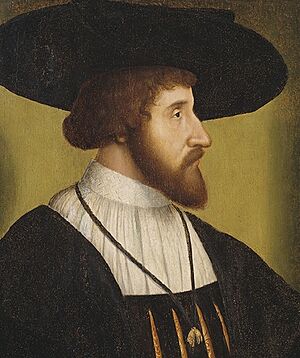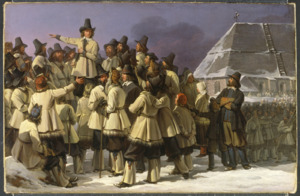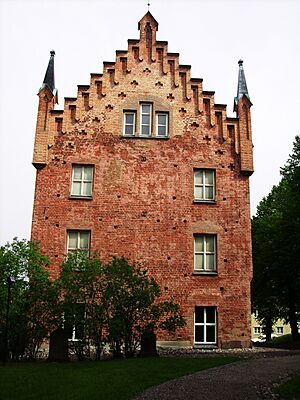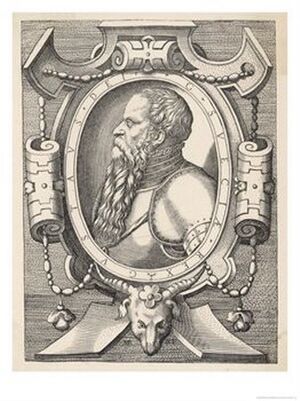Gustav I of Sweden facts for kids
Quick facts for kids Gustav I |
|
|---|---|
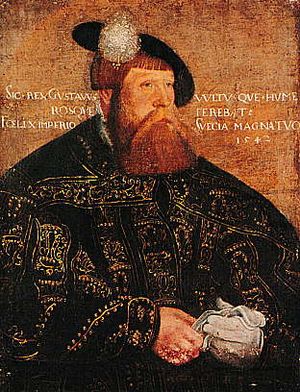
Portrait by Jakob Binck, 1542
|
|
| King of Sweden | |
| Reign | 6 June 1523 – 29 September 1560 |
| Coronation | 12 January 1528 |
| Predecessor | Christian II |
| Successor | Eric XIV |
| Born | Gustav Eriksson 12 May 1496 Rydboholm Castle, Uppland or Lindholmen, Uppland, Sweden |
| Died | 29 September 1560 (aged 64) Tre Kronor, Stockholm, Sweden |
| Burial | 21 December 1560 Uppsala Cathedral, Uppsala, Sweden |
| Spouse | Catherine of Saxe-Lauenburg (m. 1531; died 1535) Margaret Leijonhufvud (m. 1536; died 1551) Catherine Stenbock (m. 1552) |
| Issue | Eric XIV of Sweden John III of Sweden Catherine, Countess of East Frisia Cecilia, Margravine of Baden-Rodemachern Prince Magnus, Duke of Östergötland Anna Maria, Countess Palatine of Veldenz Sophia, Duchess of Saxe-Lauenburg Elizabeth, Duchess of Mecklenburg-Gadebusch Charles IX of Sweden |
| House | Vasa |
| Father | Erik Johansson Vasa |
| Mother | Cecilia Månsdotter |
| Religion | Lutheran (1523-1560) prev. Roman Catholic (1496-1523) |
Gustav I, also known as Gustav Vasa, was born Gustav Eriksson on May 12, 1496. He became King of Sweden in 1523 and ruled until his death in 1560. Before becoming king, he led a rebellion to free Sweden from Danish rule. This fight was called the Swedish War of Liberation.
Gustav became a leader after the terrible Stockholm Bloodbath, where his father was killed. When he was chosen as king on June 6, 1523, Sweden finally broke away from the Kalmar Union. This union had joined Sweden with Denmark and Norway.
As king, Gustav was a strong leader. He put down several rebellions and changed how Sweden was run. He increased taxes and started the Reformation in Sweden. This meant Sweden broke away from the Roman Catholic Church and became Lutheran. He took control of the Church's money and land.
Gustav was the first truly powerful Swedish king. He was good at organizing and spreading his message. Many stories about his adventures during the fight for freedom are still told today. In 1544, he made the Swedish crown hereditary, meaning it would pass down in his family, the House of Vasa. Three of his sons later became kings.
Many people call Gustav I the founder of modern Sweden and the "father of the nation." He compared himself to Moses, who also freed his people. Gustav was known for being tough and having a bad temper. But he also loved music and was very clever. He started one of the world's oldest orchestras, the Kungliga Hovkapellet (Royal Court Orchestra).
Contents
Gustav's Early Life
Gustav Eriksson was probably born in 1496. His parents were Cecilia Månsdotter Eka and Erik Johansson Vasa. He was likely born at Rydboholm Castle, near Stockholm. He was named Gustav after his father's grandfather.
Gustav's family, the Vasa and Sture families, were important nobles. His great-aunt was the regent of Sweden, Sten Sture the Elder. This meant Gustav grew up with a lot of family connections and land.
Fighting for Swedish Freedom
Since the late 1300s, Sweden had been part of the Kalmar Union. This union was mostly controlled by Denmark. Many Swedish nobles wanted Sweden to be independent. Gustav and his father supported Sten Sture the Younger, who was Sweden's regent from 1512. They fought against the Danish King Christian II.
Becoming a Hostage
In 1518, after a battle, Sten Sture and King Christian agreed to talk. To keep the king safe, Sweden sent six men as hostages. Gustav Eriksson was one of these men. King Christian broke his promise and took the hostages to Copenhagen.
Gustav was held at Kalø Castle. He was treated well because King Christian hoped he would switch sides. But Gustav stayed loyal to Sten Sture.
Gustav's Escape
In 1519, Gustav Eriksson escaped from Kalø. He fled to the city of Lübeck in Germany. How he escaped is not fully known. One story says he dressed up as a cattle driver.
While in Lübeck, Gustav heard about the war in Sweden. King Christian II was trying to take full control. In 1520, Christian's forces won. Sten Sture died, but some Swedish strongholds, like Stockholm, still fought back. Gustav returned to Sweden in May 1520.
The Stockholm Bloodbath
Gustav was invited to King Christian's coronation in Stockholm in November. Christian had promised to forgive his enemies. But Gustav chose not to go. The coronation happened on November 4. After a few days of celebrations, King Christian locked up his enemies.
They were accused of being against the Church. The next day, nearly 100 people were killed in the Stockholm Bloodbath. Among them were Gustav Eriksson's father, Erik Johansson. Gustav was staying nearby and escaped.
Seeking Support in Dalarna
Gustav Eriksson feared for his life. He traveled to the province of Dalarna in northwestern Sweden. Stories say he tried to gather an army there. At first, he had little success. He was chased by King Christian's men and almost fled to Norway.
But then, people in Dalarna changed their minds. They caught up with Gustav and convinced him to return to Mora. This famous journey inspired the long cross-country ski race called Vasaloppet.
The Swedish War of Liberation
Gustav Eriksson was made a leader, called a hövitsman. His rebel army grew quickly. By February 1521, he had 400 men. They were mostly from the area around Lake Siljan. The first big battle of the Swedish War of Liberation happened in April. Gustav's army defeated the king's forces.
They took the city of Västerås, which had important copper and silver mines. This gave Gustav money and more supporters. Other parts of Sweden also rebelled. In August, important nobles declared Gustav the regent of Sweden.
Many Swedish nobles who had supported King Christian now joined Gustav. Most castles and cities were taken by Gustav's rebels. But strong places like Stockholm were still held by the Danes. In 1522, the German city of Lübeck joined the war against Denmark.
In early 1523, the combined forces attacked Danish areas. King Christian II was overthrown and replaced by Frederick I. The new king wanted to rule Sweden too. Lübeck wanted Sweden to be independent, not part of a strong Danish union. Lübeck also wanted special trading rights and their loans repaid.
The Swedish leaders knew Lübeck's help was vital. So, they decided to make Gustav Eriksson king.
Becoming King
The formal election of Gustav Eriksson as king happened in Strängnäs in June 1523. The Swedish leaders chose him as king. The representatives from Lübeck fully supported this, saying it was God's will. Gustav said he had to accept what was seen as God's wish.
He swore a royal oath. The next day, priests joined Gustav. A priest named Laurentius Andreae held up a holy symbol over Gustav, who was kneeling. Gustav was then led to Strängnäs Cathedral. There, Laurentius Andreae announced Gustav Eriksson as King of Sweden. He was not crowned yet, but he was king.
Today, June 6 is Sweden's National Day of Sweden, in memory of this event.

Taking Stockholm
Soon after becoming king, Gustav gave special trading rights to Lübeck. An agreement was made with the Danish forces in Stockholm. On June 17, 1523, Gustav's rebels entered the capital city.
At Midsummer, King Gustav made a grand entrance into Stockholm. Celebrations followed, including a special church service. Gustav then moved into the Tre Kronor palace.
The War Ends
Danish officials still held castles in Finland, which was part of Sweden then. By the end of 1523, they all gave up. In August 1524, Gustav met with King Frederick of Denmark in Malmö. They signed the Treaty of Malmö.
This treaty meant Denmark recognized Sweden's independence. But Gustav did not get more land, like Gotland. The treaty officially ended the Swedish War of Liberation.
The Swedish Reformation
After Gustav became king, the old Archbishop, Gustav Trolle, was sent out of the country. Gustav asked Pope Clement VII to approve a new archbishop, Johannes Magnus.
The Pope said no. He demanded that Gustav Trolle be brought back. But Gustav Trolle had supported the Danish king. Bringing him back was impossible for Gustav.
The king told the Pope this, but the Pope still refused. Gustav, influenced by a Lutheran scholar named Olaus Petri, decided to appoint his own archbishop in 1531. This was Olaus's brother, Laurentius Petri. With this act, the Pope lost all power over the Swedish Church.
In the 1520s, the Petri brothers pushed for Lutheranism in Sweden. Many changes happened. For example, Olaus Petri, a priest, got married. He also published texts that supported Lutheran ideas. A Swedish translation of the New Testament was published in 1526. Later, a full Bible translation, called the Gustav Vasa Bible, came out in 1540–41.
Gustav I's break with the Catholic Church was similar to what Henry VIII did in England. Both kings decided to make their own choices, independent of Rome.
Gustav's Later Rule
Gustav faced resistance from some parts of Sweden. People in Dalarna rebelled three times in his first ten years as king. They thought he was too harsh on those who supported the Danes. They also did not like his new Protestant religion. Many who had helped Gustav become king joined these rebellions. They often paid with their lives.
Farmers in Småland rebelled in 1542. They were unhappy about taxes, church changes, and the king taking church bells and treasures. This uprising, led by Nils Dacke, caused Gustav a lot of trouble. The king sent letters asking other provinces to send troops to help him.
With the help of Swedish troops and German soldiers, Gustav defeated the rebels in 1543. Nils Dacke was seen as a traitor. But today, some people in Småland see him as a hero, like Robin Hood.
Gustav also had problems with the Church. In the 1540s, he sentenced the Petri brothers and his former chancellor to death. But they were all later forgiven. From 1554 to 1557, he fought a war against Ivan the Terrible of Russia, but it did not have a clear winner.
End of Gustav's Reign
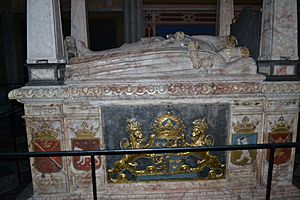
In the late 1550s, Gustav's health got worse. In 1560, he gave a "last speech" to his children and nobles. He told them to stay united. Gustav died on September 29, 1560. He was buried in Uppsala Cathedral.
Gustav's Legacy
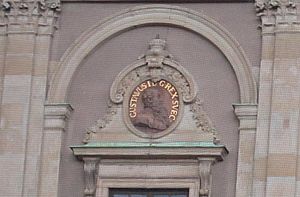
In Sweden, Gustav Vasa is seen as one of the country's greatest kings. He ended foreign rule over Sweden. He also organized the government and broke ties with Rome. He founded the Swedish Church and started the hereditary monarchy. Because of this, he is very important in Swedish history. He is often called a founding father of the modern Swedish state.
However, historians also note that he ruled with harsh methods. His legacy is important, but not always seen as completely positive.
Many stories about Gustav Vasa's life are debated. In the 1800s, many heroic tales about his adventures were told. Today, most of these stories are thought to be legends. They were likely created by Gustav himself to promote his image.
One story says he was hiding from Danish soldiers at a friend's farm. A farmhand told the soldiers Gustav was there. As soldiers searched, the landlady pretended to be angry at Gustav. She hit him with a bakery spade and called him a "lazy farm boy." She ordered him to go work. The soldiers found it funny and did not realize this was Gustav Vasa. He managed to escape.
There are many such stories about Gustav's close calls. Whether they are true or not, they are still told in Sweden today.
Gustav's memory has been greatly honored. There are history books, special coins, and the annual Vasaloppet ski race. The city of Vaasa in Finland was named after his royal family in 1606. Gustav was also shown on the 1,000 kronor banknote until 2016.
Some people see Gustav as a power-hungry ruler who wanted to control everything. But by doing so, he united Sweden. Before him, Sweden did not have a standard language, and local areas had strong power. He also laid the groundwork for Sweden's strong army. This army helped Sweden become a major power in the 1600s.
Images for kids
Gustav Vasa had a series of paintings made during his reign. The originals are lost but watercolour reproductions of unknown date remain. These paintings show Gustav's triumphs, showing what Gustav himself considered important to depict.
-
Part one. Year 1521–23, Outside Stockholm
-
Part three. Year 1527, Inside and outside Västerås
-
Part five. Year 1541, in Brömsebro with Christian III of Denmark
Gustav's Family
Gustav had three wives and many children.
His first wife was Catherine of Saxe-Lauenburg (1513–1535). They married in 1531 and had one son:
- Eric XIV (1533–1577), who later became king.
On October 1, 1536, he married his second wife, Margareta Leijonhufvud (1514–1551). They had many children:
- John III (1537–1592), who also became king.
- Katarina (1539–1610)
- Cecilia (1540–1627)
- Magnus (1542–1595)
- Carl (1544)
- Anna (1545–1610)
- Sten (1546–1547)
- Sofia (1547–1611)
- Elisabet (1549–1598)
- Charles IX (1550–1611), who also became king.
At Vadstena Castle on August 22, 1552, he married his third wife, Katarina Stenbock (1535–1621). They had no children.
See also
 In Spanish: Gustavo I de Suecia para niños
In Spanish: Gustavo I de Suecia para niños
Other sources
- Åberg, Alf (1996) Gustav Vasa 500 år / The official anniversary book (Stockholm: Norstedts) ISBN: 978-9119611628
- Larsson, Lars-Olof (2005) Gustav Vasa – Landsfader eller tyrann? (Stockholm: Prima) ISBN: 978-9151839042
- Nieritz, Gustav (2018) Gustavus Vasa, or King and Peasant: With a Historic Sketch and Notes (Forgotten Books ) ISBN: 978-0656337927
- Roberts, Michael (1968) The Early Vasas: A History of Sweden 1523–1611 (Cambridge University Press) ISBN: 978-0521311823
- Watson, Paul Barron (2011) The Swedish Revolution under Gustavus Vasa (British Library, historical print editions) ISBN: 978-1241540043


